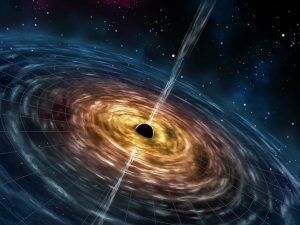In the past, 3D simulations of black hole dynamics have modelled plasma made of electrons and positrons as a continuum. Recently, and for the first time, a team of astrophysicists have calculated how individual particles of matter and antimatter swirl around a rotating black hole.
The new computer simulations provide crucial insight into how a black hole shoots out jets of matter at nearly light speed. The team’s results support two previously proposed mechanisms for how the mysterious particle streams are powered.
The new simulation technique could also help astrophysicists to interpret data from a global array of radio telescopes that are observing the supermassive black hole at the center of the Milky Way.
According to Serguie Komissarov, an astrophysicist at the University of Leeds, UK, the results are a ‘milestone’ in the study of black holes.
High-energy jets of matter are common across the cosmos and seem to emanate from a variety of sources, though there is no direct evidence yet on how they form. In our Galaxy, many neutron stars produce these jets, as do some relatively small black holes — those not much more massive than the Sun — that are in the process of absorbing matter. Astrophysicists think that some supermassive black holes at the centers of other galaxies are behind spectacular jets that extend for thousands of light years, such as those seen around galaxy Messier 87.
In the case of small black holes, the jets seem to contain a thin haze of electrons and their antimatter – positrons – streaming out as plasma at very high speeds.
The existing models of black-hole behavior indicate that particle-antiparticle pairs are produced inside high-intensity magnetic and electric fields that swirl close by a black hole’s event horizon which is the spherical surface from which nothing can escape after crossing. Most of these particles fall into the black hole.
The jets form near the black hole’s magnetic poles, where chaotic braids of twisted magnetic fields shoot out into interstellar space. According to the prevailing explanation, these fields would carry away some of the black hole’s energy and rotational momentum, as well as create more electrons and positrons.
The team’s results show turbulent currents of positrons and electrons moving in opposite directions of each other, as both swirl in a disc around the black hole’s equator. The currents cause energy to shoot out of the polar regions.
“The most important thing about the jets in general is not the plasma, but a lot of energy coming out in the electromagnetic field,” says co-author Kyle Parfrey, an astrophysicist at the NASA Goddard Space Flight Center in Greenbelt, Maryland. “We see this happening.”
But in this study, Parfrey and his collaborators included individual particles in their simulations and watched how their motions entwined with, and contributed to powering, the magnetic and electric fields.
The study also found support for a second mechanism that explains how energy is extracted from a rotating black hole — a mechanism that was first proposed by British mathematical physicist Roger Penrose in the 1960s. According to Penrose’s model, some of the particles created near the black hole’s equator have negative energy — so when they fall into the black hole, they slow down its rotation. This hypothetical phenomenon is reminiscent of the ‘Hawking radiation’ that was also proposed by the late Stephen Hawking, in which negative-energy particles contribute to shrinking a black hole’s mass.
Co-author Benoît Cerutti of the University of Grenoble Alpes in France says that the Event Horizon Telescope, a network of radio antennas spanning the globe that is due to deliver its first results this year, might provide some exciting details about how plasma moves around the supermassive black hole at the center of the Milky Way, as well as the one at the centre of Messier 87. “My hope is that we’re going to have more observational constraints soon,” Cerutti says.
According to Parfrey, the new simulations are still incomplete. In particular, they do not include the detailed physics of how particles and antiparticles are created, or of the accretion disc — the flow of material around the black hole — that is thought to power the electromagnetic fields in the first place. A black hole left in isolation from matter will rapidly dissipate these fields and settle into a quiet, dark state with no plasma jets shooting out.
Universe Kogaku designs and manufactures precision optical lenses for telescopes, security, high tech and electronic applications. We stock 1000’s of standard lens assemblies and can custom design a solution for scanners, CCTV, CCD/CMOS, medical imaging, surveillance systems, machine vision and night vision systems.